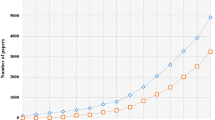Abstract
The Scholarly Database aims to serve researchers and practitioners interested in the analysis, modelling, and visualization of large-scale data sets. A specific focus of this database is to support macro-evolutionary studies of science and to communicate findings via knowledge-domain visualizations. Currently, the database provides access to about 18 million publications, patents, and grants. About 90% of the publications are available in full text. Except for some datasets with restricted access conditions, the data can be retrieved in raw or pre-processed formats using either a web-based or a relational database client. This paper motivates the need for the database from the perspective of bibliometric/scientometric research. It explains the database design, setup, etc., and reports the temporal, geographical, and topic coverage of data sets currently served via the database. Planned work and the potential for this database to become a global testbed for information science research are discussed at the end of the paper.
Similar content being viewed by others
References
Atkins, D. (2003), Revolutionizing Science and Engineering Through Cyberinfrastructure: Report of the National Science Foundation Blue-Ribbon Advisory Panel on Cyberinfrastructure. Technical Report. Retrieved December 5, 2006, from http://www.nsf.gov/publications/pub_summ.jsp?ods_key=cise051203
Börner, K., Chen, C., Boyack, K. W. (2003), Visualizing knowledge domains. In: B. Cronin (Ed.), Annual Review of Information Science & Technology, 37. Medford, NJ: Information Today, Inc./American Society for Information Science and Technology, pp. 179–255. http://www.infotoday.com/books/asist/arist37.shtml
Boyack, K. W., Mane, K. K., Börner, K. (2004), Mapping medline papers, genes, and proteins related to melanoma research. In E. Banissi (Ed), Proceedings of the Information Visualisation, Eighth International Conference on (IV’04). IEEE Computer Society, Washington, DC, pp. 965–971.
Boyack, K. W., Börner, K. (2003). Indicator-assisted evaluation and funding of research: visualizing the influence of grants on the number and citation counts of research papers. Journal of the American Society for Information Science and Technology, 54(5): 447–461.
Boyack, K. W., Wylie, B. N., Davidson, G. S. (2002), Domain visualization using VxInsight for science and technology management, Journal of the American Society for Information Science and Technology, 53(9): 764–774.
Chen, C. (2002), Mapping Scientific Frontiers. Springer-Verlag, London.
Garfield, E. (1955), Citation indexes for science: A new dimension in documentation through association of ideas, Science, 122(3159): 108–111.
Hitchcock, S., Brody, T., Gutteridge, C., Carr, L., Harnad, S. (2003), The impact of OAI-based search on access to research journal papers, Serials, 16(3): 255–260.
Klavans, R., Boyack, K. W. (2006), Identifying a better measure of relatedness for mapping science, Journal of the American Society for Information Science and Technology, 57(2): 251–263.
Novak (2006), CF Dynamics Zip Code Database. Retrieved December 4, 2006, from http://www.cfdynamics.com/zipbase/
Shiffrin, R. M., Börner, K. (Eds.) (2004), Mapping knowledge domains, Proceedings of the National Academy of Sciences of the United States of America, 101(Suppl_1): 5183–5185.
Tichenor, S. (2006), Application software for high performance computers: A soft spot for U.S. business competiveness, CTWatch Quarterly, 2(4A): 1–6. http://www.ctwatch.org/quarterly/articles/2006/11/application-software-for-high-performancecomputers-a-soft-spot-for-us-business-competitiveness/
White, H. D., Mccain, K. W. (1998), Visualizing a discipline: An author co-citation analysis of information science, 1972–1995, Journal of the American Society for Information Science, 49(4): 327–356.
Author information
Authors and Affiliations
Corresponding author
Rights and permissions
About this article
Cite this article
LaRowe, G., Ambre, S., Burgoon, J. et al. The Scholarly Database and its utility for scientometrics research. Scientometrics 79, 219–234 (2009). https://doi.org/10.1007/s11192-009-0414-2
Received:
Published:
Issue Date:
DOI: https://doi.org/10.1007/s11192-009-0414-2




